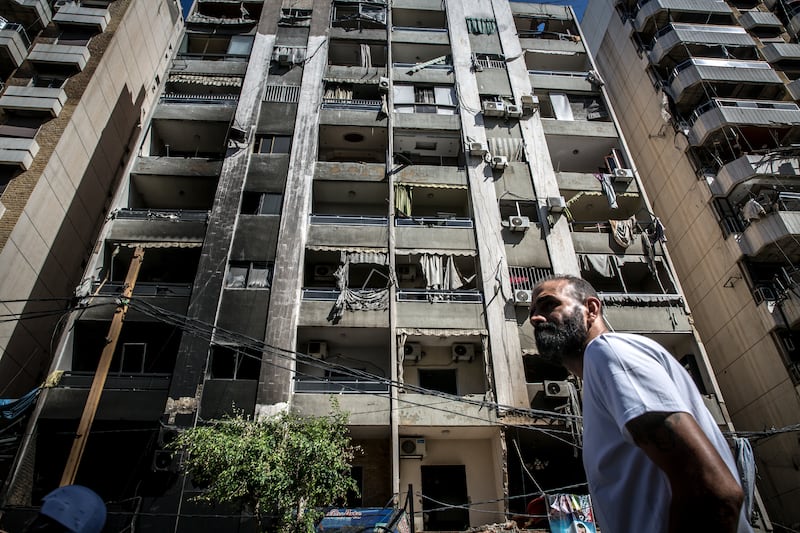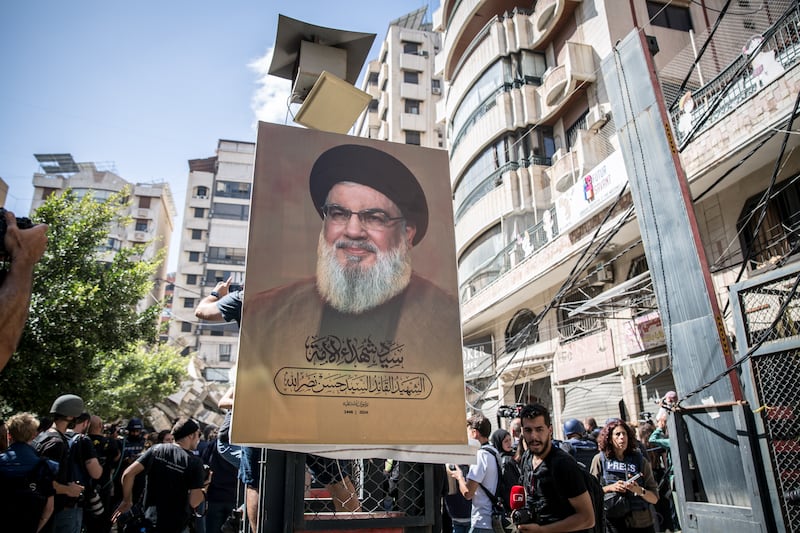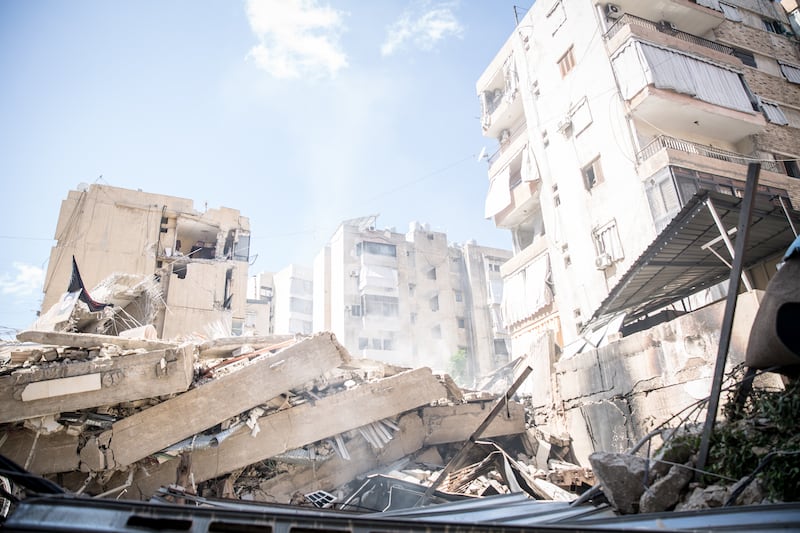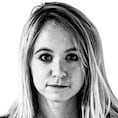Hundreds of journalists – largely clad in flak jackets and ballistic helmets – assembled on Wednesday for a Hizbullah-organised media tour. The militant group and political party had promised rare access to Beirut’s southern suburbs, which were largely off-limits over the last fortnight of punishing Israeli air strikes in Lebanon – both due to Hizbullah restrictions and because of the risk of attacks.
The bombings, which usually happen at night, are audible across the capital but have mostly been confined to this area, which is known as Dahiyeh. Sometimes, they come after warnings given by the Israeli Defence Forces (IDF); other times there are none.
Dahiyeh is usually home to close to a million people, but it resembled a ghost town as a convoy of cars and motorbikes drove between the three sites that Hizbullah members selected. Journalists were shown whole buildings that had been levelled. Smoke was rising from two of the sites.
Along the thoroughfare between stops, there were many undamaged buildings. But there were also signs of decimated civilian life, even as Israel claims it is only hitting Hizbullah targets and infrastructure. Bookshelves were visible inside a second-floor apartment missing its outer wall; a shop sign was hanging with its electrics exposed; and a gym had its workout machines intact, but covered in thick white dust.
READ MORE
This area suffered huge damage before, during the 34-day 2006 war between Israel and Hizbullah, when more than 1,100 Lebanese people were killed and roughly one million displaced, according to Human Rights Watch. This period gave birth to the so-called Dahiyeh doctrine, when Gadi Eizenkot, the head of Israel’s northern command and subsequently IDF chief of staff, suggested “wield[ing] disproportionate power against every village from which shots are fired on Israel, and caus[ing] immense damage and destruction. From our perspective, these are military bases… This isn’t a suggestion. This is a plan that has already been authorised.”

In more recent years, Dahiyeh was bustling and full of life. Now it stands suddenly empty again, with former residents describing to The Irish Times their struggles to evacuate with little notice: one struggled to convince an elderly parent with a disability to leave home; while another talked about the challenge of transporting his 10 cats. Even the Lebanese army checkpoints in Dahiyeh have been abandoned.
Across the nation, Lebanese authorities say about 1.2 million people have now been displaced – a huge proportion of Lebanon’s population of roughly 5.2 million.
Hizbullah’s 32-year-long leader Hassan Nasrallah was killed on September 27th in Dahiyeh, in a series of air strikes involving dozens of 2,000 tonne bombs known as “bunker busters”. The explosions echoed across the city and levelled a block of apartment buildings.
[ Confusion among Irish troops in Lebanon over obligation to protect civiliansOpens in new window ]
The site of Nasrallah’s assassination was notably not included on the Hizbullah-led media tour, though posters commemorating his life were stuck up across the areas of Dahiyeh that journalists were permitted to see, along with text calling Nasrallah a “martyr leader” and saying “may God be pleased with him”.
At various points, Hizbullah members made statements in support of the group and their recently deceased leader. “Our loyalty is to you, Nasrallah,” one man climbed atop rubble to shout. Some of those directing the trip kept on surgical face masks.

Mohammed Afif, the head of Hizbullah’s media relations, made a potentially risky appearance to reiterate Hizbullah’s claims that civilian buildings are being hit and weapons were not being stored there, as the IDF says. The following day, a building Hizbullah had used as a media relations office was also hit by an air strike.
As the tour was ongoing, a man approached The Irish Times, asking whether he could film our journalist saying whether she had seen rockets or other weaponry at any of the sites – that request was declined. It was not clear whether he was a member of Hizbullah.
In other parts of Beirut, many residents have felt a sense of security until now, saying they live in places where Hizbullah supporters – who are predominantly Shia Muslim – are not a majority. But even as Dahiyeh continues to be targeted – with large plumes of smoke rising from there most of Thursday – the areas attacked by Israel are expanding. A first strike this week hit close to Beirut’s busy Kola intersection, where many locals go to board taxis and buses to other parts of the country.
[ Joe Biden says he is against Israeli strikes on Iran’s nuclear facilitiesOpens in new window ]
Early on Thursday morning, another strike hit a medical facility in Bachoura, a short walk from Lebanon’s parliament, a United Nations regional headquarters and various western embassies. It was also close to Martyrs’ Square, where civilians displaced from Dahiyeh and southern Lebanon have been sleeping in the streets. Nine people were killed and 14 injured in that attack alone, according to Lebanon’s health ministry. Its statement said DNA tests were still being completed to determine the identity of some of the remains.
Each night, Beirut’s residents now wonder where will be hit next, and which other parts of the city and areas around it could soon become like Dahiyeh is now.

- Find The Irish Times on WhatsApp and stay up to date
- Our In The News podcast is now published daily – Find the latest episode here






















